Capitalize on rising opportunities in Asian markets
main text
Capitalize on rising opportunities in Asian markets
As one of the fastest-growing regions in the world, Asia is expected to lead global growth in 2023, according to S&P Global Market Intelligence. The article examines the rising opportunities in Asia brought about by the Regional Comprehensive Economic Partnership (RCEP) agreement, the Guangdong‑Hong Kong‑Macao Greater Bay Area (GBA), as well as national policies and development schemes amid a challenging global backdrop.
RCEP opens doors for business growth
Today, many Asian companies are export-oriented, driving the expansion of international trade in the region. Most importantly, the RCEP, which covers about a third of the world economy, is set to create the largest free trade bloc in the world.
The 15 signatories to the RCEP agreement, including China, 10 ASEAN member states, South Korea, Japan, Australia, and New Zealand, can now benefit from tariff elimination on more than 90% of goods over time.
With this driving force injected by the RCEP, Asia is growing into the global manufacturing hub. According to the data from the United Nations, Asia’s industrial value-added spiked from US$2.7 trillion in 2000 to US$9.4 trillion in 2019, whilst Asia’s share of world industrial value-added grew from 35.9% to 50.9%. Among them, the share of China soared from 6.4% to 24.9%, while the share of ASEAN also rose from 2.8% to 4.8%.
Focusing on the 15 members of the RCEP, they had a combined share of 40.2% by 2019, compared to 29.4% in 2000. Data revealed by Chinese Customs shows that, in 2021, imports and exports between China and the other 14 RCEP members totalled RMB 12.07 trillion (up 18.1% by year), accounting for 30.9% of China’s total foreign trade value.
As the RCEP brings new development to businesses in the region, the Greater Bay Area firms can also leverage the opportunities to go global.
ASEAN remains a bright spot for investors
According to World Economic Forum, ASEAN will become the world’s fourth largest economy by 2030, with a consumer market worth more than US$4 trillion.
The region was also among the fastest growing regions of the world in 2022. However, the Asian Development Bank (ADB) forecasted that the economic growth in 2023 will slightly fall from 2022. This is mostly a result of tightening monetary policy and deteriorating global economic conditions.
In spite of a more challenging macroeconomic climate, the ASEAN region will remain attractive to foreign direct investment, thanks to its rising domestic demand, advancing business policies and infrastructure, and competitive wages.
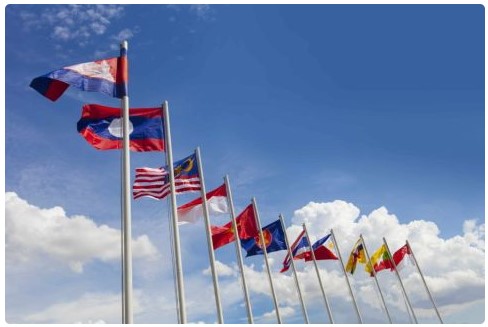
The ASEAN region is attractive to foreign direct investment due to rising domestic demand and competitive wages.
What's more, the RCEP is a major inflection point in the post-pandemic economic recovery and will benefit ASEAN member countries with its trade liberalization and preservation of multilateral trading systems.
The RCEP's inclusion of the automotive industry is deemed to be complementary. The University of Duisburg-Essen’s CAR Institute predicted that about 41.8 million vehicles will be sold in RCEP nations by 2030, making up 46% of global market share.
The enormous potential brought by RECP bodes well for the plastics and rubber industries, as the automotive industry is the third-largest user of plastics after packaging and construction, and a significant consumer of rubber.
While it is still in its early stages of embracing a circular economy, ASEAN is grappling with resource depletion, unsustainable raw material usage, defects in product value chains, and climate change.
As reported by World Bank, in Malaysia, the Philippines, and Thailand, less than 25% of recyclable plastics are converted into useful materials; while over 75% of the material value of the plastics is lost, equating to US$6 billion annually across the three countries. This poses a challenge yet an enormous economic opportunity if it can be transformed into high-quality recycled feedstock.
In fact, numerous young ASEAN businesses are seizing the opportunity. Indonesian companies such as Kibumi, Octopus and Bantubumi are mobilizing collectors in innovative ways while the Plastic Flamingo, Green Ant and Envirotech are just a few of the Philippine producers who convert waste plastic into building materials. There is plenty of room for many more.
Indonesia
Indonesia is the largest economy in ASEAN and the fifth largest among the RCEP parties. The World Bank projected Indonesia’s economy to grow by 4.8% in 2023.
The entry into force of the RCEP Agreement for Indonesia in January 2023 brings the full implementation of the agreement one step closer to making ASEAN the hub of production networks.
Moreover, as more businesses adopt the Indonesian National Standard (Standar Nasional Indonesia, or SNI) to guarantee the quality of their products, Indonesia's manufacturing industry is setting a new benchmark for quality and competitiveness. Until 2022, SNIs that are in harmony with international standards has increased by 26%.
The international collaboration plays an important role in driving growth in the country. In November 2022, ExxonMobil and Pertamina, the Indonesian state-owned energy company, have signed a Heads of Agreement at the G20 Bali Summit to further progress their previously announced regional carbon capture and storage hub for domestic and international CO2.
The agreement will not only support Indonesia’s 2060 net-zero ambition, but also enable growing economy and add revenues for the country.
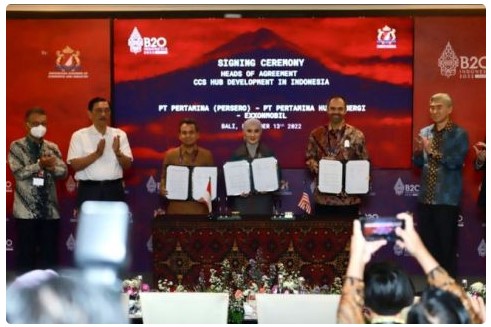
ExxonMobil and Pertamina have signed a cooperation agreement for developing carbon capture and storage.
In the meantime, ExxonMobil, PT Indomobil Prima Energi (IPE), an Indonesian-based Indomobil Group subsidiary, and Plastic Energy, a provider in advanced recycling, have signed a MoU at the sidelines of the G20 Bali Summit.
The partnership is set to assess the potential for large scale implementation of advanced plastic recycling technology in Indonesia. The advanced recycling capacity being assessed as a part of the collaboration is expected to be 100,000 metric tons per year.
Thailand
With the aim of spurring exports and lessening the negative impact of a global economic slowdown in 2023, Thailand has geared up and set up “war rooms”, according to the Ministry of Commerce.
Thai exporters are working with the government to explore three high-potential markets, namely the Middle East, South Asia, and CLMV (Cambodia, Laos, Myanmar and Vietnam). The exports to the three markets are expected to reach THB 2 trillion in 2023.
In an effort to speed up the production of EVs and the development of supporting infrastructure, the Thai government has approved a new EV policy, which is geared towards ensuring that by 2035, all vehicles produced in Thailand will be EVs.
Under the new plan, Thailand is to produce 1.051 million EVs by 2025, before jumping up to 6.22 million by 2030.
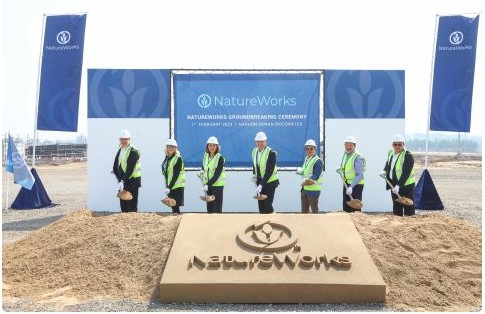
NatureWorks hosted a ceremonial groundbreaking for their new Ingeo PLA manufacturing complex in Thailand.
This opens up more opportunities as EV parts are shifting to lightweight materials like plastics and other novel engineering materials to meet the demand for lighter EVs.
Thanks to a number of incentive schemes launched by the government, the Thai plastic industry is attracting investments and solutions from domestic and abroad.
For instance, NatureWorks has selected TTCL Public Company Limited, a Thailand-based integrated construction company, as the general contractor for procurement, construction, commissioning, and startup support services for their new Ingeo PLA manufacturing complex in Thailand.
The new facility, which has an annual production capacity of 75,000 tonnes of biopolymers, is expected to complete in the second half of 2024.
Malaysia
Having strong resilience during the pandemic, the Malaysian plastics industry continues on a stable growth trajectory.
According to the Malaysian Investment Development Authority (MIDA), 33 projects in the sector had been approved with accumulated investments of RM503.5 million as of June 2022.
Meanwhile, the Malaysian Plastics Manufacturers Association (MPMA) urged the government to swiftly ratify the Comprehensive and Progressive Agreement for Trans-Pacific Partnership (CPTPP) to enable the plastics industry to reap the benefits of the agreement.
The removal of import tariffs and non-tariff barriers will increase the price competitiveness of the country’s export of plastic products, and open up greater export opportunities to CPTPP countries, including new market access to Canada and Mexico.
Besides, it is worthy of note that Malaysia has embarked on the journey toward circular development. The Ministry of Environment and Water (KASA) has implemented the Malaysia Plastics Sustainability Roadmap to phase out problematic single-use plastics against a 76% average collected-for-recycling rate by 2030, with long-term aims to achieve a 100% recycling rate for plastic packaging by 2050.
To support Malaysia to achieve its national sustainability targets, Rebound Plastic Exchange, a global B2B digital trading platform for recycled plastics, has been ready for buyers and sellers to access a global marketplace for quality assured feedstock.
In terms of EV market, Malaysia is shifting its focus from popularising domestic EV use to producing components, such as high quality and durable rubber tyres, as stated by NanoMalaysia, the nation’s agency for localisation of EV technology development.
This has the potential to give the country an advantage in the EV race, given that Malaysia is one of the world’s major producers and exporters of rubber products.
Vietnam
According to the International Monetary Fund (IMF), Vietnam's GDP rose to 7% in 2022, making it a growth hotspot in Asia-Pacific.
Vietnam’s upbeat outlook contrasts with a slowdown trend in other parts of Asia due to lower inflation which is also different from the overall picture in this region.
Currently, Vietnam is heavily relying on the import of PVC resins in the plastic production chain. But Vietcombank Securities Co (VCBS) forecasted that decreased PVC prices will support profit margins of businesses in the second half of 2022 and in 2023.
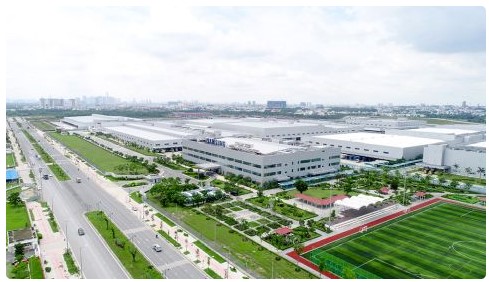
Samsung has been raising its investment in Vietnam.
Between 2023 and 2026, Vietnam will also see a considerable increase of polyolefin capacity. The country’s polypropylene output could more than double in the next three years, and could also produce polyethylene for the first time if all the projects announced to date proceed as expected.
The Hanoi government is enlisting private partners to carry out its expansion plans more swiftly, and it also plans to expand the geographic spread of manufacturing further north.
On top of that, the surging inflow of foreign direct investment has demonstrated foreign investors’ confidence in the Vietnamese economy. The local media reports stated that Korean electronics giant Samsung has set to pour US$2 billion into Vietnam, raising its total investment in the country to US$20 billion. The additional investment would go to advanced areas like artificial intelligence and big data.
Asahi Intecc Hanoi, a subsidiary of the Japanese medical device producer Asahi Intecc, has also obtained an investment permit for the construction of a US$74 million facility in the northern province of Vinh Phuc. The facility is expected to start operation in the first quarter of 2025.
Tapping GBA’s unique strengths as a business platform
The development of the Greater Bay Area is accorded the status of vital strategic planning in China's development blueprint, playing a significant role in the country's implementation of innovation-driven development.
With 24 Fortune 500 companies and 57,000 high-tech companies, the region has outstanding industrial supporting advantages. And what behind it are eight trillion-level industrial clusters in Guangdong Province, providing support for the entire industrial chain.
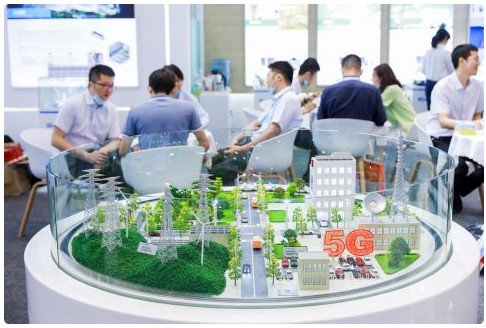
Greater Bay Area plays a significant role in China’s implementation of innovation-driven development.
In 2021, the GBA’s total economic output reached RMB 12.6 trillion, accounting for about 12% of China's total economic output with less than 1% of its land area.
All these factors have distinguished the region, bringing in foreign investment and securing business deals. At the 2022 Global Investment Promotion Conference for the GBA, more than 800 cooperation projects were reached at the conference, with a total investment of RMB 2.5 trillion, or around US$360 billion.
Tapping into a sound industrial system, active innovation, and strong connectivity, the GBA will continue to build a strong foundation for the growth of trade and investment cooperation in the region.
Source : https://www.adsalecprj.com/web/news/article_details?id=60644&lang=1
Edit : HANDLER
- PreviousA load of latest plastics and rubber applications in automobiles 23.05.21
- NextPlastics and a very fast acceleration for EVs 23.04.20
